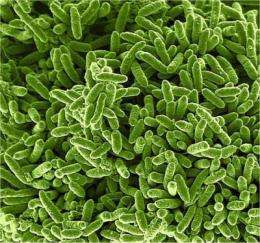Tasting carbon with WAFT'ed light: New instrument analyzes tiny samples at low pressure and temperature

(Phys.org) -- When delving into the nuances of carbon dioxide, a new instrument designed by scientists at Pacific Northwest National Laboratory "sips" the sample and reveals information about the source of the different carbon dioxide molecules. Using lasers and a technique dubbed WAFTing, the instrument measures the ratio of different types or isotopes of carbon in tiny samples. Called a capillary absorption spectrometer, the instrument is as precise as existing technologies that require 10,000 times more sample.
"It allows us to use very, very small samples—far less than the current systems," said Dr. Thomas Blake, a chemical physicist who helped design the device. "And, we didn't sacrifice precision to analyze those samples."
Developing the CAS was motivated by a need to track the source of nutrients extracted from microbial communities. Understanding how microbial communities convert materials like cellulose into energy-dense compounds like glucose is an important piece in the puzzle of sustainable energy sources. Also, the precise, rapid, and inexpensive measurements made by CAS apply to homeland security, forensics, biology, chemistry, and atmospheric sciences related to pollution and climate change, where sensitivity is crucial when only vanishingly small amounts of material are available. The extreme sensitivity of the CAS holds the promise of measuring carbon-14, which can currently only be measured by accelerator mass spectrometers costing several million dollars.
To simulate the natural variation in carbon isotopic ratios on the microscopic scale, the CAS team carefully prepared and extensively characterized carbon dioxide gas samples with various amounts of carbon-13. This isotope of carbon has a slightly different electronic structure than the carbon-12 that makes up most of the stuff around us. The slight difference alters the way the laser light is affected by the sample allowing the CAS to "taste" the unique flavor of a given carbon-13 to carbon-12 ratio. The extreme specificity of the CAS allows this ratio to be determined even in the presence of high levels of other molecules such as nitrogen dioxide, ubiquitous in the modern world, which confuse traditional methods for measuring carbon-13.
In the CAS, the gaseous sample flows into a capillary, a silica tube with reflective coating on the inside. The capillary is about a meter long with an inside diameter of a millimeter. This small diameter allows scientists to interrogate every molecule maximizing overall sensitivity.
"The molecules have no other place to go," said Dr. M Lizabeth Alexander, a senior research scientist in the Environmental Molecular Sciences Laboratory at PNNL who worked on this innovation. "In other systems, you have a fairly large volume, and not all molecules interact with the laser at all times, but not with this technology."
In the past, the biggest problem has been introducing the laser beam into the capillary without light bouncing and scattering off the capillary walls and the target, creating feedback and adding noise or randomness and uncertainty to the data. This problem has resulted in the use of pulsed lasers in current commercial devices and other research laboratories, which in turn requires working at near atmospheric pressures, precluding the measurement of the miniscule samples. The PNNL researchers chose to use a continuous laser, which reduced the required amount of sample even further. They used every trick in the book, to reduce feedback noise, but there was still more noise than the team wanted.
So, they pulled out a heat gun.
Using this simple device, which like a hair dryer, aims a column of heat at a target, they WAFTed the optical properties of the air traversed by the laser en route to the capillary. WAFTed, a term the team created, stands for warm air finesse tuning; it translates into waving a heat gun in front of the laser to create random variations in how light travels through the air.
By WAFTing the laser, the team greatly reduced the finesse involved in the undesired reflections from the capillary. In scientific circles, finesse involves how light bounces back and forth, reflecting off different surfaces. The heat gun randomizes the photons from the reflected light, almost completely eliminating feedback and noise caused by these reflections from the capillary back into the laser.
"This is truly a novel and low-cost approach to reducing the noise in our data," said Dr. Robert Sams, who wielded the heat gun for many of the experiments the team ran.
The team has published results of testing the device on samples as small as 20 picomoles. Recent improvements have reduced this to 1 picomole of total carbon dioxide or 10 femtomoles of carbon-13. This translates into the detection of around ten trillionths the number of carbon dioxide molecules present in one cubic centimeter of the ambient air, very sensitive tastebuds indeed! For comparison, the current workhorse systems used in labs requires over 10,000 times more sample to obtain the same level of precision.
"I believe this technology fills a niche between the molecular level and the macroscopic world, a niche that has not been explored," said Dr. James Kelly, a veteran laser scientist at PNNL who worked on developing the new technology.
The fine-tuning continues. The researchers are working to get accurate answers from ever-smaller samples, with a goal of precisely measuring less than 1 femtomole of carbon-13. Getting answers from small samples could save significant costs for biofuel researchers.
More information: JF Kelly, et al. 2012. "A Capillary Absorption Spectrometer for Stable Carbon Isotope Ratio (13C/12C) Analysis in Very Small Samples." Review of Scientific Instruments 83(2):023101. DOI: 10.1063/1.3680593
Journal information: Review of Scientific Instruments
Provided by Pacific Northwest National Laboratory















